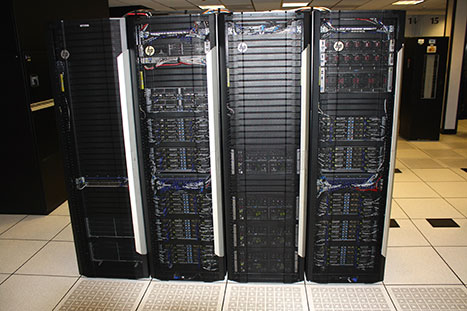New Supercomputer Allows for Massive Data Analysis in Less Time
UH Center for Advanced Computing and Data Systems Acquires Powerful Cluster
The University of Houston is adding a new, state-of-the-art supercomputer to its arsenal of research tools. Used primarily for scientific and engineering work, this powerful, high-performance computing system will have the computing power of more than 450 conventional desktops, which more than doubles the current computing power at UH.
 Unlike conventional computers, supercomputers have a large number of CPUs that function
simultaneously and can be used together to collaboratively solve very large problems
or analyze large data sets. With huge storage capacity and very fast input/output
capabilities, this supercomputer will enable researchers at UH to perform massive
computations on extremely large amounts of data in a short period of time.
Unlike conventional computers, supercomputers have a large number of CPUs that function
simultaneously and can be used together to collaboratively solve very large problems
or analyze large data sets. With huge storage capacity and very fast input/output
capabilities, this supercomputer will enable researchers at UH to perform massive
computations on extremely large amounts of data in a short period of time.
The cluster was procured by the Center for Advanced Computing and Data Systems (CACDS) and will be jointly operated by CACDS and the UH Information Technology’s Research Computing Center.
“The acquisition of this new system marks the start of a new era of supercomputing not only for the University of Houston, but also for the surrounding community,” said Rathindra Bose, vice president for research and technology transfer at UH. “With this new system, we are on our way to becoming Houston’s primary source for supercomputing resources and expertise. The new system will allow us to conduct research in a variety of fields.”
Computers like the one purchased by CACDS are used throughout academia and industry to solve problems that are too big for individual PCs to handle. Houston’s two major industries, energy and health, benefit from large-scale computing.
Computing of this magnitude is especially critical in the energy industry, where it’s used in the search for oil and is key to better utilizing existing oil fields. The power of supercomputing also is increasingly employed in health and medical research, where it is advancing health care. With the ability to cull through gigabytes and terabytes of patient information, supercomputers assist in determining how to best treat specific illnesses, as well as diagnose them more quickly, decrease costs and improve quality.
“This resource will enable us to better serve our current users, as well as expand our user base to reach even further into the research community,” said Barbara Chapman, director of CACDS and professor of computer science in the College of Natural Sciences and Mathematics.
“Much of today’s research exploits computers to perform experiments and to evaluate very large amounts of data. This new supercomputer will allow us to bring breakthrough technologies to a new generation of researchers hoping to solve tomorrow’s problems today,” Chapman said.
Already the central source for high-performance computing expertise and facilities at UH, CACDS offers resources and services to researchers whose tasks require significant amounts of computing and large-scale data analysis and visualization. CACDS also provides training in different aspects of high-performance computing for UH faculty, staff and students to enable them to effectively use high-performance computing in their ongoing research.
For more information on the new supercomputer, visit http://www.cacds.uh.edu/Opuntia.
- Lisa Merkl, University Media Relations